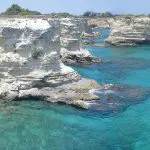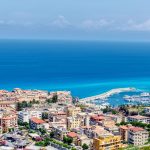Puglia, located in the southeast of Italy, forms the heel of Italy’s boot and is almost entirely surrounded by two seas: the Adriatic and the Ionian. Its important and strategic geographical position has made it a highly desirable place to settle and control. As a result, the region is home to many castles that were built and rebuilt to protect it from enemies.
Just like we’ve done with Calabria and Sicily, we are sharing our five favorite castles that can be found in Puglia. And remember, if you want to explore southern Italian culture for yourself in Italy, there is no better way than taking a guided tour led by local experts. Browse My Bella Vita Travel’s full selection of Small Group Trips to Italy.

Castel del Monte (Andria)
This castle was built in the 13th century by Emperor Frederick II on a hilltop overlooking the town of Andria in the province of Barletta-Andria-Trani. Castel del Monte is one of the most fascinating castles constructed by Frederick II, who is responsible for many castles found throughout Puglia. The design of the castle is unique, forming a perfect octagon with octagonal-shaped towers at each corner. Inside, the courtyard also forms an octagon, and each floor includes eight rooms. Unlike typical castles, you won’t find a moat or a drawbridge here; however, some of the lavish marble decorations that once adorned the rooms can still be seen today. This medieval masterpiece became a UNESCO World Heritage Site in 1996, and the image of Castel del Monte appears on the reverse side of the Italian one-cent euro coin.
Castello Aragonese (Taranto)
The Castello Aragonese in Taranto, also known as Castel Sant’Angelo, has a rich and ancient history that has become increasingly clear due to recent excavations. Remnants of earlier structures dating back to ancient Greece and Byzantium are still visible today. The “new” castle was rebuilt between 1487 and 1492 on the orders of Ferdinand of Aragon, the King of Naples. Currently, the castle is owned and operated by the Italian Navy, which offers free guided tours in both Italian and English every two hours.
Castle of Charles V (Lecce)
This castle, located near Piazza Sant’Oronzo, was originally built in the Middle Ages and later reinforced by Charles V in the 16th century to include a fortified watchtower known as Torre Quadrata. Once a formidable military stronghold, the castle now stands at the border of the old and modern towns. It was formerly surrounded by a moat and had two drawbridges—one facing west and the other facing east. Today, visitors can explore the castle and admire its long hallways, spacious rooms with high vaulted ceilings, and beautiful stained glass windows.

Castle of Otranto (Otranto)
Otranto, founded as a Greek town, is an ancient seaside port town located on the Adriatic coast. The castle in the heart of Otranto was originally reinforced by Frederick II and was later rebuilt for Alfonso of Aragon. Then, after the historical Saracen attack in 1480, it was once again reinforced to include cannon towers. The castle originally had one drawbridge entrance, and there is a dry moat that surrounds the entire perimeter of the castle. When visiting the castle, you should climb to the top of the walls for outstanding views overlooking the town and out to the harbor.
The castle is perhaps most famous due to associations with English writer Horace Walpole’s classic novel The Castle of Otranto. The castle in Walpole’s gothic novel was, in fact, actually modeled on the author’s own London mansion, Strawberry Hill. However, he had taken the name Otranto from an ancient map of Italy that adorned the wall of his writing room. The connections may be tenuous, but bookworms will still want to pay a visit to this fabulous town and its fortifications.
Castle of Trani (Trani)
Trani is a seaport located on the Adriatic Sea just north of Bari. You certainly can’t miss the massive Swabian castle known as the Castle of Trani which was built by none other than Frederick II between 1233 and 1249. The castle seems to grow out of the sea, showing off its defensive prowess as the waves of the surrounding waters crash against its mighty walls. The castle is quadrangular, with square towers at each corner to defend the castle from threats by land and sea. Surrounding the castle was once a moat that was filled with seawater. However, it has since been filled in. Much later, in the early 1800s, the castle became a prison, and it wasn’t until 1979 that the castle became open to the public to view.
Now, what are you waiting for? Begin planning your own epic adventure in Italy! See Calabria and beyond with My Bella Vita Travel’s expert guides leading the way. Browse our Small Group Tours in Calabria and Southern Italy.

 (
( (
( (
(






